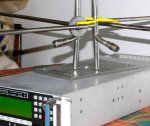Fredva
One (of many) solution to re-solving the weak signals from the one repeater that isn't quite within range is to use a directional antenna.
Lots of different types: the photo below is of a Watkins Johnson broadband dual/linear polarised directional Yagi i.e. it is equally sensitive to both horizontaly and verticaly polarised signals - can be used to receive both at the same time, or just one of either, or when both element array pairs are connected does a good job receiving circular/elyptical polarised signals). This Yagi offers 2.8dBi - 7.1dBi gain from 152.00Mhz - 1.370Ghz, with a average gain of just under 5dBi across the same bandwidth
That is jolly useful extra gain, but the real beauty of directional antennas?: they are quite deaf to signals (in or out of bandwidth) that arrive from all directions, except the direction to which they are pointed, and consequently they introduce a lot less rf noise to the receiver.
End result: a stronger and less noisy (quieter) signal for your receiver to deal with and demodulate ..... has to be a good thing(?).
While this antenna is a pro made mil spec example made of stainless steel (and dual polarised - you only need a vertical polarised i.e. single plane), they are easy DIY projects. Aluminium tubing from DIY or hobby shops does fine, and the internet has quite a few "on-line calculator" pages - just fill in the upper and lower frequency your Yagi needs to work on, the gain you would like to have, and the program throws out the number of elements needed and the spacing between the elements. Also, if you do decide to build one of these: while reducing the element diameter as they become shorter and the resonant frequency increases (as has been done with this antenna), does improve antenna factor and gain, in a receive only antenna where VSWR tends not to be a big issue, the benefits generally don't justify the extra work (and cost) involved - follow through the entire construction with a single suitable element diameter and all will be fine. And last but not least - take note when choosing an on-line calculator to use to get dimensions for your DIY Yagi, whether or not it is calculating for a Yagi that has it's elements isolated from the boom, or as in this example, provides dimensions for a Yagi with elements in electrical contact with the boom: forgetting to factor this into the design can have a significant impact on your antenna performance.
To give you an idea of size I took the picture alongside a WJ-8700 receiver - the antenna is 35" (wide at base element pair) x 55" (high to top of blue cap)
The purpose of the 2 x N-type connectors(?): to facilitate horizontal or vertical polarised signal reception, or when both are connected at the same time (through a mast mounted combiner), to provide horizontal & vertical reception concurrently, or, reception of left and/or right handed circular polarised signals.
NOTE TO MODERATOR - these pic's loaded a lot bigger than I anticipated - by all means halve their size if you wish.



